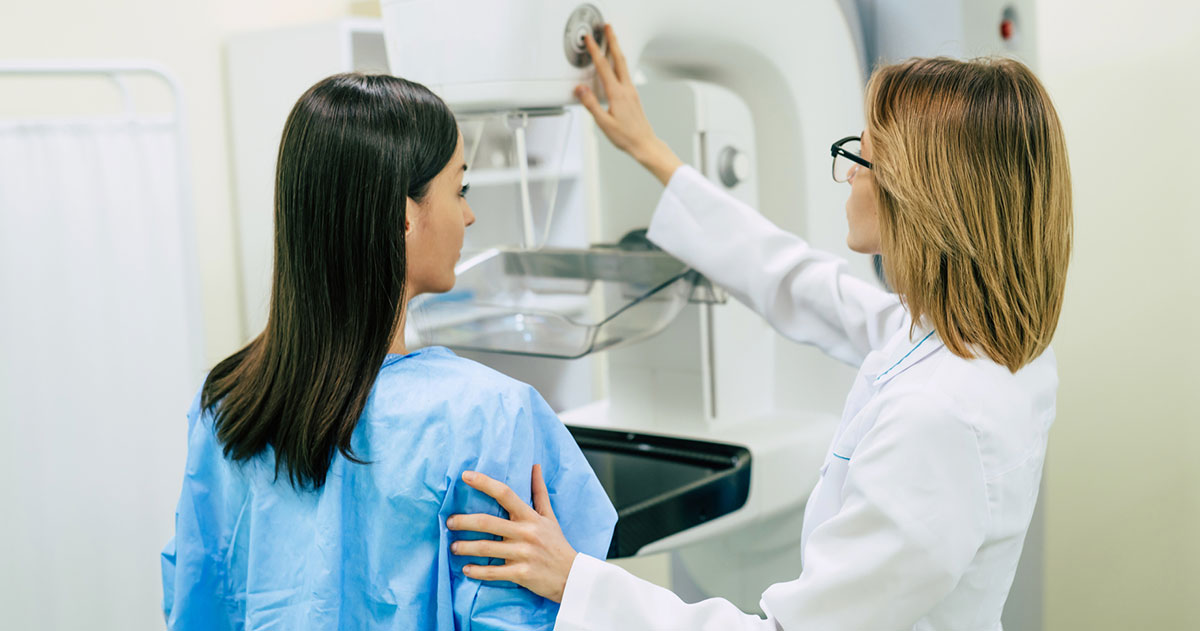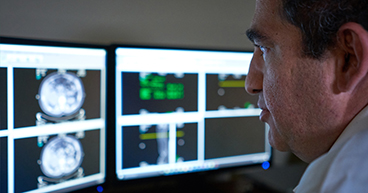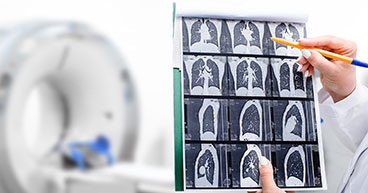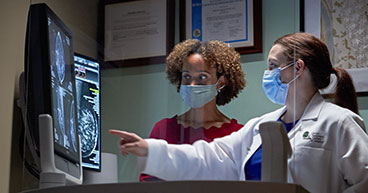
Experts agree that regular mammograms to screen for breast cancer are a key to early detection. But it may seem as if some experts and health care advocacy groups and agencies keep moving the goal posts on screening recommendations.
What age should you start getting routine mammograms? How often? When should you stop? And what else can you do to reduce your breast cancer risk?
In the last 30 years, screening guidelines have changed frequently and were often conflicting, depending on which organizations published them. Now a new draft recommendation expected to be finalized by the end of 2023 from the U.S. Preventative Task Force (USPTF), a federal panel of experts that issues guidelines about preventative care, may clear up some—but not all—of the confusion.
In this article, we’ll discuss:
- What are the proposed breast cancer screening guidelines?
- How often should you get a mammogram?
- When should you stop getting mammograms?
- Know your breast cancer risks
- What are some of the common breast cancer risk factors?
- What can you do to lower your risk for breast cancer?
If you’ve been diagnosed with breast cancer and want to get a second opinion on your diagnosis or treatment options, call us or chat online with a member of our team.
What are the proposed breast cancer screening guidelines?
For women at average risk, the new USPTF recommendation lowers the age to begin routine mammograms to age 40—10 years earlier than previous guidelines. The change is based on research showing the risk of breast cancer in younger women has been climbing. The National Cancer Institute reports that between 2016 and 2019 (the most recent data available) breast cancer rates increased nearly 3 percent annually in women under age 50.
Oncologists: Mammogram age change may save lives
Karen Smorowski, MD, a Radiation Oncologist at City of Hope Chicago and a breast cancer survivor, applauds lowering the age to begin screening. Having been diagnosed with early-stage disease at age 40, Dr. Smorowski believes the change may help save lives.
Anita Johnson, MD, a Surgical Oncologist at City of Hope Atlanta agrees.
“Younger women often present at a later stage because most primary care physicians think people that young can’t get breast cancer, but it does happen,” she says.
The proposed USPTF guidelines apply only to women, who account for more than 99 percent of all breast cancer diagnoses. While men can get breast cancer too—about 2,700 cases are diagnosed every year—it is not usually recommended they get regular screenings for the disease.
Inherited gene mutations may also increase cancer risk in both sexes, but they’re likely to affect men and women differently. Men may also have BRCA mutations, but they are more likely to put them at a higher risk of prostate cancer rather than breast or other cancers. Men, however, should talk to their doctors if they detect any changes in their breasts, such as a lump, thickening of the skin or an inverted nipple.
How often should you get a mammogram?
If you’re at average risk, USPTF is now recommending mammograms every two years. However, this guidance differs from many agencies and cancer hospitals, most of which recommend annual screenings.
The USPTF guideline is important because the Affordable Care Act requires private insurers to cover with no copay all exams and procedures the panel recommends. Currently, insurers adhere to the USPTF’s 2002 recommendation, which covers mammograms annually. But, in 2025, that could change to every two years.
“Part of the difficulty is there are many different studies out there. Some studies are old, some used technology for screening that’s now outdated,” says Cynthia Lynch, MD, a Medical Oncologist at City of Hope Phoenix. “However, The American Cancer Society (ACS) and National Comprehensive Cancer Care Network (NCCN) indicate there’s enough data to show there’s a reduction in mortality when you screen on an annual basis versus every two years.
“At City of Hope, we recommend annual mammograms.” Dr. Lynch says.
Here are recommendations for screening mammograms from relevant agencies and organizations:
- USPTF: Currently 50, annually; new recommendation age 40, every two years
- American College of Obstetricians and Gynecology (ACOG): Age 40, annually
- American College of Radiology (ACR): Age 40, annually
- NCCN: Age 40, annually
- Society of Breast Imaging (SBI): Age 40, annually
- ACS: Ages 40 to 54, annually; ages 55 to 74, every two years
These guidelines only apply to people assigned female at birth who are at average risk for breast cancer.
Dr. Johnson believes a one-size-fits-all approach to breast cancer screening is not ideal. "We know that [Black women] present at a much younger age,” she says. “The death rate for Black women is also 40 percent higher than all races, and ethnicities. We actually need personalized screening, including race-specific mammography criteria and guidelines based not just on age, but on risk factors."
One research study— Women Informed to Screen Depending on Measures of risk (WISDOM)— is evaluating a personalized approach to breast cancer screening based on each woman’s risk as determined by individual risk factors for breast cancer, including breast density, genes and family health history.
When should you stop getting mammograms?
Most agencies agree that the decision to stop screening should be up to the individual. A woman in good health should discuss whether to continue screenings with her doctor at around age 75.
The ACS states: “Women should continue screening with mammography as long as their overall health is good, and they have a life expectancy of 10 years or more.” The USPTF does not include screening recommendations for women over age 75, saying more research is needed to better understand the benefits and risks.
Know your breast cancer risks
While guidelines are helpful, it’s important to assess your individual breast cancer risk, based on your genetic profile, family history, lifestyle and other factors. Experts recommend asking your primary care doctor or gynecologist to conduct a personal risk assessment by age 30. If you’re at increased risk, your doctor may suggest earlier breast cancer screening, more frequent or intensive screening and medications to proactively reduce your risk.
A risk assessment is based on your age, reproductive history (such as when you started your period, if you gave birth and what age you gave birth) and other factors known to increase risk.
What are some of the common breast cancer risk factors?
It’s important for women to know the risk factors for breast cancer, even those they can’t control, including those listed below:
Family history: Risk is higher if relatives have been diagnosed with cancer, especially breast and ovarian cancers.
Inherited mutations: BRCA1, BRCA2, RTPEN and/or TP53 gene mutations linked to breast cancer may be revealed with a genetic test
Pre-cancer: Having been diagnosed with pre-cancerous conditions found in a breast biopsy, such as atypical hyperplasia or lobular carcinoma, may increase risk.
Radiation therapy: Your risk is elevated if you’ve had radiation therapy to treat a previous cancer, such as thyroid cancer or lymphoma before age 30.
Dense breasts: Breast density is determined by a mammogram. Nearly half of all women have dense breasts, which have more glandular and fibrous tissue than fatty tissue. The new USPTF recommendation calls for more research to determine if additional screening with breast ultrasound or MRI will benefit women with dense breasts.
Ethnicity and race: Black women have the highest risk of developing breast cancer. American Indian and Alaska Native women are on the lowest end of risk. Asian/Pacific Islander and Hispanic/Latina women’s risk rates fall in between.
Age: Breast cancer risk increases with age. Most breast cancers are found in women ages 55 and older. Black women have the highest breast cancer rates among women under age 40.Additional factors you can control that may increase your breast cancer risk include those below.
Alcohol consumption: Drinking alcohol is linked to increased risk for developing breast cancer. The risk increases with the amount of alcohol consumed.
Obesity: Fat tissue may contribute increases in estrogen level, and high estrogen levels may increase breast cancer risk. A body mass index (BMI) of over 30 is considered obese.
Sedentary lifestyle: Research shows that sitting for prolonged periods is associated with a higher risk for developing cancer, as well as heart disease, diabetes, depression and anxiety.
Hormone therapy: Birth control pills and medical devices as well as combined hormone replacement therapy (HRT), used to treat symptoms of menopause, may increase the risk for developing breast cancer. Discuss the pros and cons of hormone therapy with your doctor when you consider your breast cancer risk.
What can you do to lower your risk for breast cancer?
Know your breasts: Routine breast self-exams are no longer recommended as a tool to screen for breast cancer--simply because mammograms are more accurate. But it’s still important to be aware of any visible changes and report them to your doctor. Look for changes to your breasts’ texture, such as dimpling, swelling or puckering. Also, check for lumps or discharge from the nipples.
Maintain a healthy weight: Obesity has been linked to 13 types of cancer, including breast cancer. If your body mass index (BMI) is over 25, consider collaborating with a dietitian to find a weight loss plan that works for your lifestyle, making it more likely that you’ll stick with it.
Increase physical activity: ACS recommends 150 to 300 minutes of moderate intensity exercise, such as brisk walking, or 75 to 150 minutes of more intense activity, like running, each week. The more physical activity you do, the greater the benefits. Get the all-clear from your doctor before making major changes to your exercise regimen.
Sit less: Exercise alone doesn’t undo the negative impact on your body of sitting for hours at a time. However, five minutes each hour of standing activity (walking around your chair, folding laundry or taking out the trash) is enough to offset some of the effects of extended sitting.
Reduce alcohol intake: For women, that means no more than one drink per day. Also, be aware of how much you’re drinking: A standard drink is about 14 grams of alcohol—that’s 12 ounces of regular beer, 5 ounces of wine or 1.5 ounces of distilled spirits. If you’re filling an oversized glass, that one drink could really count as two.
Stop smoking: Researchers have found that smoking is associated with increased risk of breast cancer in certain women, including: women who:
- Started smoking before age 17
- Smoked for at least 10 years
- Smoked more than five cigarettes a day
- Have a family history of breast cancer
Establish a personal screening plan and stick to it: Schedule a doctor’s visit to discuss your breast cancer risk factors and make a personal mammogram screening plan. Getting regular mammograms enables your doctor to compare results over time and identify breast changes or abnormalities unique to your breasts. Mammograms are proven to identify breast cancer early, often before signs or symptoms occur, when its most treatable.
If you’ve been diagnosed with breast cancer and want to get a second opinion on your diagnosis or treatment options, call us or chat online with a member of our team.



